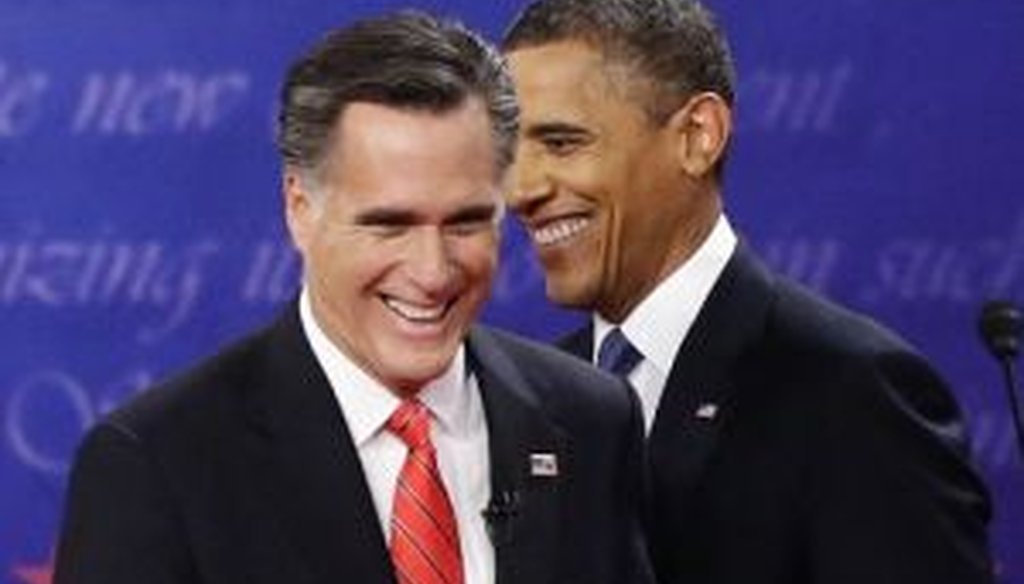

Our only agenda is to publish the truth so you can be an informed participant in democracy.
We need your help.


President Barack Obama and Mitt Romney met for the first presidential debate in Denver on Oct. 3, 2012. We fact-checked several claims from the debate.
During the first presidential debate in Denver, Mitt Romney warned that the U.S. risks harming its economy if government spending continues at its current pace.
"Spain spends 42 percent of their total economy on government," Romney said. "We’re now spending 42 percent of our economy on government. I don’t want to go down the path to Spain."
We looked into the scale of government in a previous item, which we’ll update here with the most recent figures.
The Office of Management and Budget produces a table every year that tracks total government expenditures as a percentage of gross domestic product. Here are the statistics for the past few fiscal years in question:
Fiscal year 2007: 30.9 percent
Fiscal year 2008: 32.6 percent
Fiscal year 2009: 37.1 percent
Fiscal year 2010: 35.4 percent
Fiscal year 2011: 35.4 percent
So by this measurement, Romney’s 42 percent figure is a little high.
However, there is another measurement that backs up Romney’s claim. The Organization of Economic Cooperation and Development -- a group that includes most of the world’s advanced industrialized countries -- found that government expenditures accounted for 42 percent of the U.S. economy in 2009 (compared to 45.8 percent for Spain).
Since the OMB data showed that government spending as a share of the economy peaked in 2009 before declining, likely because it was the first year of the recession, it seems reasonable to assume that the percentage will drop for subsequent years once the next OECD calculations are released. Still, it’s likely that Romney’s 42 percent figure is pretty close to accurate.
However, using only the big-picture numbers tells only part of the story. Here’s the breakdown of spending for 2011, according to OMB:
Federal expenditures for defense and international accounts: 5.0 percent
Federal net interest expenditures: 1.8 percent
Federal Social Security and Medicare expenditures: 8.6 percent
Federal payments to individuals exclusive of Social Security and Medicare: 7.1 percent
Federal spending in all other categories: 1.9 percent
State and local government: 11.0 percent
Total: 35.4 percent
So payments to individuals accounted for almost half of federal expenditures. Why is this important? It’s a question of control, Gary Burtless, an economist with the Brookings Institution told us when we originally looked at this question.
These transfer payments, as they are known, "can be more or less freely spent by private individuals," Burtless said. "Your mom can spend her Social Security check any way she wants -- on food, shelter, vacations at Disney World or deposits in her bank account or her favorite mutual fund. Even cash public assistance recipients have pretty wide freedom over how they spend their welfare checks."
Some transfer payments are more restrictive, such as food stamps or Medicare and Medicaid benefits, but these still allow some degree of consumer choice.
"This distinction is important for a simple reason," Burtless said. While lawmakers and government officials have direct say over many types of government expenditures, "their say over government transfers is a lot more restricted."
In addition, he said, many government transfer payments "are paid for with earmarked taxes – FICA and unemployment insurance taxes. When we get transfers from the government under Social Security, Medicare and unemployment insurance, we’re getting back the money that we or our employers contributed when we were working."
While these are undoubtedly government expenditures, one could argue that they are actually pass-throughs of payments from the American public to itself. And it’s worth noting that Social Security and Medicare -- the drivers of government growth -- are among the most popular of all government programs.
(PolitiFact has noted that Burtless contributed $750 to Obama’s campaign in 2011. However, in 2008 he provided advice on aspects of labor policy to the presidential campaign of Sen. John McCain, R-Ariz., and he has worked as a government economist and served on federal advisory panels under presidents of both parties.)
Our ruling
Depending on which data set you use, Romney’s numbers are either correct or close. But they don’t tell the whole story. A large share of the spending has come not from the cost of government employees, buildings and equipment but from transfer payments that individual Americans ultimately control (and, in many cases, under programs which they had paid into to begin with). On balance, we rate Romney’s statement Mostly True.
Mitt Romney, transcript from the presidential debate in Denver, Oct. 3, 2012
PolitiFact, "Romney says government has grown from 27 percent to 37 percent of U.S. economy," Aug. 12, 2011
Office of Management and Budget, "Table 15.5—Total Government Expenditures by Major Category of Expenditure as Percentages of GDP: 1948–2010," accessed Aug. 12, 2011
Organization for Economic Cooperation and Development, "General government expenditures as a percentage of GDP (2000, 2007 and 2009)," accessed Oct. 3, 2012
E-mail interview with Gary Burtless, senior fellow at the Brookings Institution, Aug. 12, 2011
In a world of wild talk and fake news, help us stand up for the facts.
